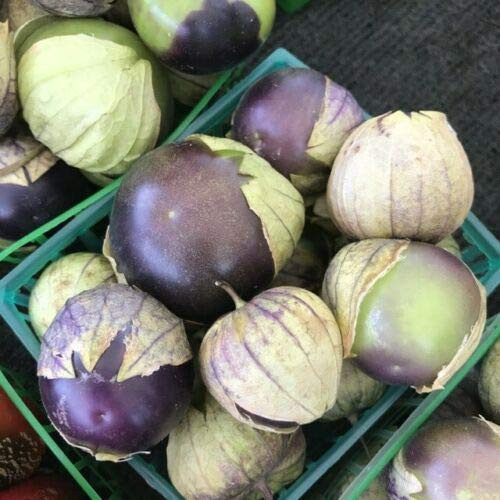65 days. A larger Tomatillo variety from Mexico, averaging 2 inches across. This is the seed to have if you want to do Salsa Verde. Green tomatoes don't work well as they tend to make a muddy colored salsa. These are the Husk Tomatoes that are used. Pick when the husk is paper brown and the fruit is breaking out of the husk. When the fruit is more yellow, it has a plum - like flavor, when more green, it has a lemony flavor. Mexicans prefer the greener for Salsa Verde as they are firmer and have a bit of a bite. The over-ripe yellow fruit is good for eating out of hand or in a compote or jam as it is sweeter. Also makes a good sauce for over fish because of the lemon flavor. Try it in spaghetti sauce! Height 3-4. Heavy yielding, 4-7 lb per plant. Fully ripe fruit will fall from the plant. Similar to Ground Cherries but much larger. I have 3 varieties of Tomatillo seeds and 3 varieties of Ground Cherry seeds for sale. All About Tomatillo also known as Husk Tomato, Mexican Groundcherry, Mexican Husk Tomato, Miltomate, Tomate de Cáscara, Tomate de Fresadilla, Tomate Milpero, Tomate Verde, Physalis philadelphica Tomatillos grow in the summer garden just like their relatives: tomatoes, eggplants, and peppers. In fact, the leaves look a little like the foliage of eggplant, but the fruit is like no other. Tomatillos are meatier than tomatoes; fruit color ranges from green through yellow and red to purple, depending on variety and ripeness. Tomatillo fruit can be as small as ½ inch in diameter or up to 2 to 3 inches, depending on variety. They are sweet and tart at the same time. You will need two or more tomatillo plants for the blooms to be pollinated and fruit to be produced. Tomatillos are ridiculously easy to grow. You should start plants indoors 3-8 weeks before the last frost date for transplanting them into the garden.
10 Seeds MEXICAN STRAIN TOMATILLO Yellow Organic Husk Tomato Miltomate
Was:
$113.78
Now:
$56.89
- SKU:
- YTH244174
- Condition:
- New
- Availability:
- Free Shipping from the USA. Estimated 2-4 days delivery.







